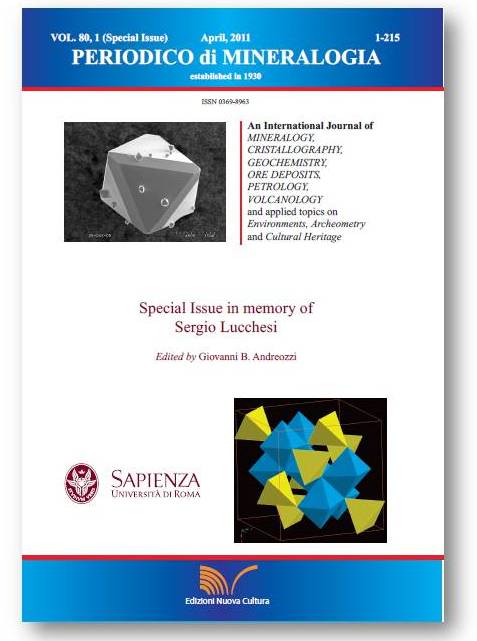High temperature structure and thermal expansion of Co<sub>3</sub>Al<sub>2</sub>Si<sub>3</sub>O<sub>12</sub> garnet
DOI:
https://doi.org/10.2451/2011PM0011Keywords:
garnet, thermal expansion, Cobalt, synchrotron radiation, powder diffraction, crystal structure.Abstract
Periodico di Mineralogia (2011), 80, 1 (Special Issue), 135-144 - DOI: 10.2451/2011PM0011
Special Issue in memory of Sergio Lucchesi
High temperature structure and thermal expansion of Co3Al2Si3O12 garnet
Mario Tribaudino1,* and Haruo Ohashi2
1Dipartimento di Scienze della Terra, Università di Parma, Italy
2Hashi Institute for Silicate Science, Nishinakanobu 1-9-25, Shinagawa, Tokyo 142-0054, Japan
*Corresponding author: mario.tribaudino@unipr.it
Abstract
Synchrotron radiation powder diffraction patterns were taken on synthetic Co3Al2Si3O12 garnet at BM8-GILDA (ESRF), at T = 298, 423, 573, 723 and 873 K. The cell parameters and atomic positions were refined by Rietveld analysis; the volume thermal expansion coefficient is αV = 28.5(9) x10-6 K-1.
The results on synthetic Co3Al2Si3O12 garnet were compared with the high temperature structure data of X3Al2Si3O12 garnets with X = Mg, Ca, Mn and Fe taken from literature. The thermal expansion of the unit cell is very similar in X3Al2Si3O12 garnets, whereas the thermal expansion of the longest bonds in the distorted cubic cage surrounding the X cation decreases with increasing cation size. Contrarily to the compression behaviour, the thermal expansion in X3Al2Si3O12 garnets does not change significantly as a function of composition.
Key words: garnet; thermal expansion; Cobalt; synchrotron radiation; powder diffraction; crystal structure.


